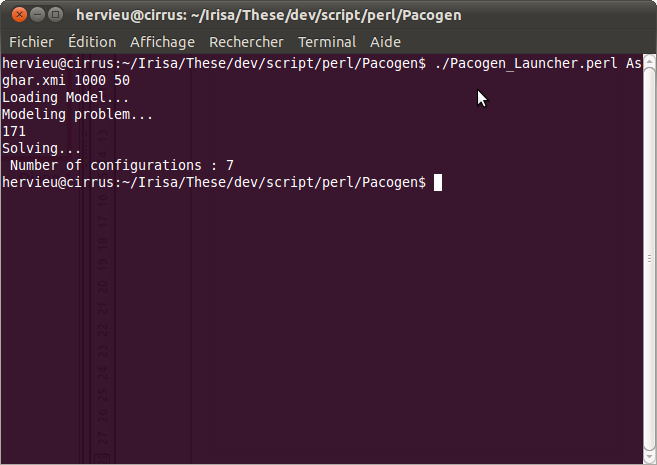To launch the tool use this command :
./Pacogen_Launcher.perl InputModel TimeMinization Size
- InputModel: File describing the feature model, it reads xmi files or text file which contains a textual description of the feature model.
- Size: the internal size of the matrix to be used to generate pairwise covering test sets
- TimeMinimization: the maximum time allocated to the generation (in ms). '_' will return the first solution without minimization.
Experimental results
rawData.html
Textual description of the model
The textual description of the model is composed of two list, separated by a ";". First list contain the list of all the feature, separated by a ",", in upper cases. The second list describe the relationships between all those features.Relationships are described like this : and(ROOT,[Children list]).
Actually there are 6 operators :
and(ROOT,[Children list]).
or(FATHER,[FT1 ,FT2])
xor(FATHER,[FT1 ,FT2])
optionnal(FATHER,[FT1 ,FT2])
require(FT1 ,FT2)
mutex([FT1 ,FT2])
For the solving process the value of the root node as to be set at 0.
Traduction example :
A,B,C,D,E,F;and(0,[A,B]),xor(A,[C,D]),or(B,[E,F]),require(D,E)
Screenshots

Resolving Process

References
2013 Dusica Marijan, Arnaud Gotlieb, Sagar Sen, Aymeric Hervieu:
Practical pairwise testing for software product lines. SPLC 2013: 227-235
2012 Arnaud Gotlieb, Aymeric Hervieu, Benoit Baudry:
Minimum Pairwise Coverage Using Constraint Programming Techniques. ICST 2012: 773-774
2012 Aymeric Hervieu, Benoit Baudry, Arnaud Gotlieb:
Managing Execution Environment Variability during Software Testing: An Industrial Experience. ICTSS 2012: 24-38
2011 Aymeric Hervieu, Benoit Baudry, Arnaud Gotlieb:
PACOGEN: Automatic Generation of Pairwise Test Configurations from Feature Models. ISSRE 2011: 120-129
2012 Arnaud Gotlieb, Aymeric Hervieu, Benoit Baudry:
Minimum Pairwise Coverage Using Constraint Programming Techniques. ICST 2012: 773-774
2012 Aymeric Hervieu, Benoit Baudry, Arnaud Gotlieb:
Managing Execution Environment Variability during Software Testing: An Industrial Experience. ICTSS 2012: 24-38
2011 Aymeric Hervieu, Benoit Baudry, Arnaud Gotlieb:
PACOGEN: Automatic Generation of Pairwise Test Configurations from Feature Models. ISSRE 2011: 120-129
2010 A. Hervieu "Using constraint model to generate automatically pairwise test set for feature diagrams" INSA's Internship report -- June 2010